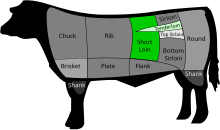Our website is made possible by displaying online advertisements to our visitors.
Please consider supporting us by disabling your ad blocker.
T-bone steak
This article needs additional citations for verification. (February 2024) |
 Beef Cuts (American terminology) | |
| Type | Short loin and tenderloin cut of beef |
|---|---|
| Part of a series on |
| Steak |
|---|

The T-bone and porterhouse are steaks of beef cut from the short loin (called the sirloin in Commonwealth countries and Ireland). Both steaks include a T-shaped lumbar vertebra with sections of abdominal internal oblique muscle on each side. Porterhouse steaks are cut from the rear end of the short loin and thus include more tenderloin steak, along with (on the other side of the bone) a large strip steak. T-bone steaks are cut closer to the front, and contain a smaller section of tenderloin. The smaller portion of a T-bone, when sold alone, is known as a filet mignon (called fillet steak in Commonwealth countries and Ireland), especially if cut from the small forward end of the tenderloin.
Experts differ about how large the tenderloin must be to differentiate T-bone steak from porterhouse. The United States Department of Agriculture's Institutional Meat Purchase Specifications state that the tenderloin of a porterhouse must be at least 1.25 inches (32 mm) wide at its widest, while that of a T-bone must be at least 0.5 inches (13 mm) wide.[1]
Owing to their large size, and as they contain meat from two of the most prized cuts of beef (the short loin and the tenderloin), T-bone steaks are generally considered one of the highest quality steaks, and prices at steakhouses are accordingly high. Porterhouse steaks are even more highly valued owing to their larger tenderloin.
In British usage, followed in the Commonwealth countries, "porterhouse" often means a British sirloin steak (i.e. US strip steak) on the bone, i.e. without the tenderloin on the other side of T-bone. Some British on-line butchers also offer American style porterhouse steaks.
In New Zealand and Australia, a porterhouse is sirloin steak (strip steak in USA) off the bone.
The earliest mention of the term "porterhouse steak" in a newspaper appears to have been in a letter written by Thurlow Weed that appeared in the Hartford Courant on August 9, 1843, but the following year (August 24, 1844) it also appeared in a list of food prices in The New York Herald, and it appeared regularly in newspapers after that.
- ^ United States Department of Agriculture (November 2014). Institutional Meat Purchase Specifications (PDF). Fresh Beef Series 100. p. 68. Archived (PDF) from the original on 21 December 2016. Retrieved 18 June 2021.
Previous Page Next Page


